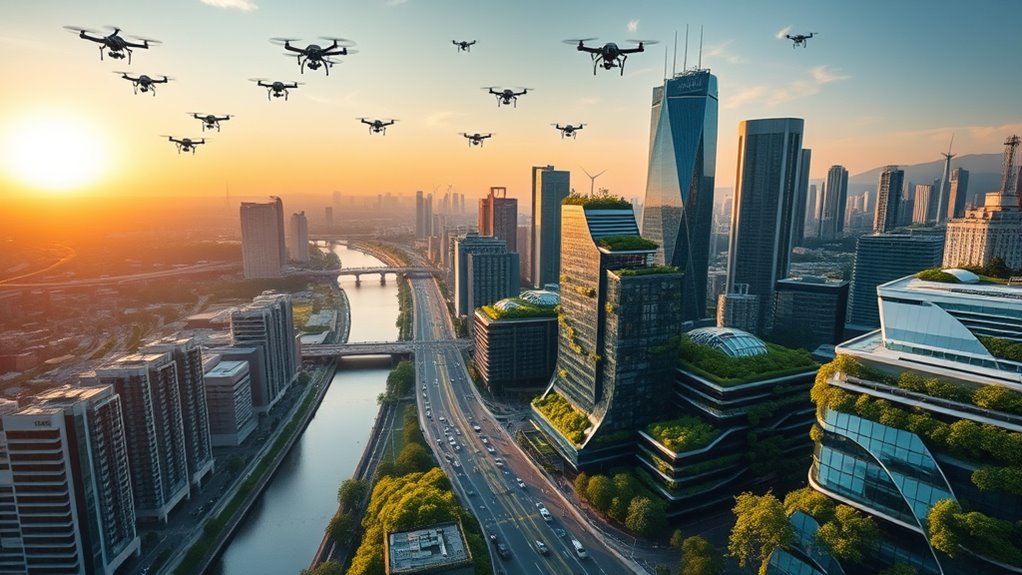By 2025, AI will play a pivotal role in tackling climate challenges by optimizing renewable energy use, improving weather and climate predictions, and supporting conservation efforts. You’ll see AI analyzing environmental data, monitoring ecosystems, and predicting extreme weather events more accurately. Smart urban planning and transportation will become more sustainable, boosting resilience against climate impacts. Continuing to explore these innovations will reveal how AI is shaping a healthier planet for future generations.
Key Takeaways
- AI will enhance renewable energy forecasting, optimizing grid efficiency and reducing reliance on fossil fuels by 2025.
- Advanced AI-driven conservation tools will enable real-time ecosystem monitoring and rapid response to environmental threats.
- Remote sensing technologies powered by AI will provide comprehensive data to monitor inaccessible regions and inform policy decisions.
- Climate modeling with AI will improve predictions of extreme weather events and sea-level rise, aiding disaster preparedness.
- AI will support sustainable urban development through smarter transportation, infrastructure planning, and climate resilience strategies.

Have you ever wondered how artificial intelligence can help protect our planet? In 2025, AI is increasingly becoming a vital tool in addressing climate challenges, especially through innovative approaches to renewable energy and conservation strategies. You might not realize it, but AI-driven technologies are transforming how we generate, optimize, and store clean energy. For instance, AI algorithms analyze weather patterns and solar or wind data to forecast energy production with remarkable accuracy. This means power grids become more efficient, reducing waste and ensuring that renewable sources are fully utilized. By predicting fluctuations in energy supply, AI helps manage demand, encouraging the integration of renewable energy into our daily lives seamlessly. This not only decreases our reliance on fossil fuels but also accelerates the transition to a sustainable future.
AI also plays a pivotal role in conservation strategies. It helps monitor ecosystems, track endangered species, and analyze deforestation patterns in real time. With AI-powered drones and remote sensing technologies, you can now get detailed insights into environmental changes across vast and hard-to-reach areas. This immediate access to data enables quicker responses to threats like illegal logging or habitat destruction. Furthermore, AI models can predict how climate change impacts specific regions, guiding policymakers and conservationists to implement targeted measures. These strategies make conservation efforts more effective and resource-efficient, ensuring that efforts are directed where they’re needed most. Remote sensing technologies are especially crucial in providing comprehensive environmental data that would be difficult to gather manually.
Additionally, AI enhances climate modeling, allowing you to better understand future scenarios and plan accordingly. By processing enormous datasets—climate data, satellite images, and environmental reports—AI helps create more accurate predictions of extreme weather events, sea-level rise, and other climate phenomena. This foresight allows communities to prepare better, minimizing damage and safeguarding vulnerable populations. Furthermore, AI supports smart urban planning, optimizing transportation systems, and reducing emissions. Cities can analyze traffic flows, suggest eco-friendly routes, and promote sustainable practices more effectively with AI insights, making urban environments more resilient to climate impacts.
In essence, AI’s integration into renewable energy and conservation strategies is revolutionizing how we combat climate change. You’re part of a global effort where technology amplifies human actions, making sustainability more achievable and immediate. As AI continues to evolve in 2025, its potential to help protect our planet becomes even more promising, guiding us toward a healthier, greener future.
Frequently Asked Questions
How Can AI Predict Specific Local Climate Impacts Accurately?
You can predict local climate impacts accurately by using machine learning and data modeling. These tools analyze vast amounts of historical and real-time data, identifying patterns and correlations specific to your area. By training algorithms on localized climate data, you enhance prediction precision. This approach allows you to understand potential impacts better, enabling proactive measures and informed decision-making to address climate challenges effectively.
What Are the Ethical Considerations of Deploying AI in Environmental Management?
Like Pandora opening her box, deploying AI in environmental management raises ethical questions. You need to reflect on privacy concerns, ensuring data collection respects individual rights. Be vigilant about algorithmic bias, which can unfairly impact communities or ecosystems. Transparency and accountability are essential to prevent misuse. By addressing these issues, you can harness AI’s power responsibly, protecting both the environment and the people depending on it.
How Accessible Are AI Tools for Small-Scale or Developing Communities?
You might find that AI tools are increasingly accessible to small-scale or developing communities, thanks to efforts to improve community access and reduce technological affordability barriers. Many organizations are working to democratize AI, offering affordable solutions and local training. While challenges remain, ongoing innovations aim to guarantee these communities can leverage AI for climate resilience, enabling them to address environmental issues effectively and participate actively in sustainable development.
What Measures Ensure AI Solutions Do Not Harm Biodiversity?
Think of AI solutions as delicate tendrils reaching into nature’s web. To protect biodiversity and support ecological monitoring, you should implement strict ethical guidelines, conduct thorough impact assessments, and involve local communities in decision-making. Regularly update AI models to recognize new threats and guarantee transparency. These measures help guarantee AI acts as a guardian rather than a threat, preserving the intricate balance of our planet’s ecosystems.
How Will AI Handle Unforeseen Climate Change Scenarios?
AI will handle unforeseen climate change scenarios by using advanced predictive modeling and scenario planning. You’ll see AI analyze vast data sets to identify potential future risks, even those not previously considered. It adapts quickly, updating models as new information emerges, allowing you to prepare for unexpected shifts. This proactive approach helps you develop resilient strategies, ensuring you’re better equipped to respond to unpredictable climate challenges effectively.
Conclusion
By 2025, AI will be your trusty eco-ally, helping you tackle climate challenges with innovative solutions. Think of it as your personal Starkiller, harnessing data to brighten Earth’s future. As you navigate this AI-powered era, remember that technology, like a satellite in a sci-fi saga, can guide us through stormy weather. Embrace these tools now, and you’ll be shaping a sustainable world that future generations will thank you for—just like heroes of old, but in the digital age.









